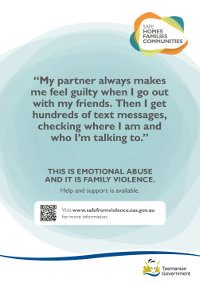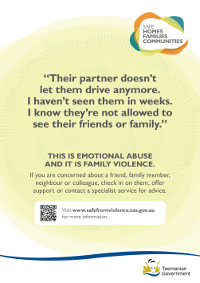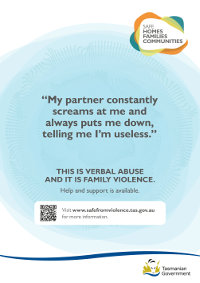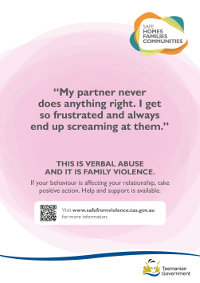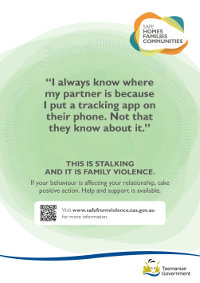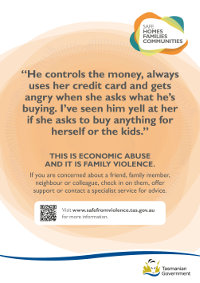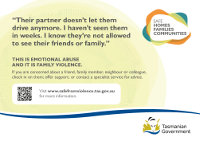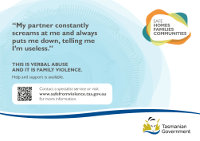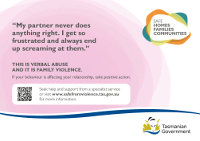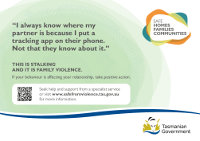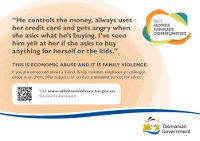In Tasmania, the Family Violence Act 2004 (Tas) defines family violence. Family violence includes non-physical types of abuse.
Coercive control
Coercive control is pattern of acts of assault, threats, humiliation and intimidation or other abuse that is used to harm, punish, or frighten a victim-survivor.
This controlling behaviour is designed to make a person dependent by isolating them from support, exploiting them, depriving them of independence and regulating their everyday behaviour.
Tasmania is the only jurisdiction in Australia to have made coercive controlling behaviours an offence.
Economic abuse
A person must not, with intent to unreasonably control or intimidate his or her spouse or partner or cause his or her spouse or partner mental harm, apprehension or fear, pursue a course of conduct made up of one or more of the following actions:
a) coercing his or her spouse or partner to relinquish control over assets or income;
b) disposing of property owned -
- i. jointly by the person and his or her spouse or partner; or
- ii. by his or her spouse or partner; or
- iii. by an affected child –
without the consent of the spouse or partner or affected child;
c) preventing his or her spouse or partner from participating in decisions over household expenditure or the disposition of joint property;
d) preventing his or her spouse or partner from accessing joint financial assets for the purposes of meeting normal household expenses;
e) withholding, or threatening to withhold, the financial support reasonably necessary for the maintenance of his or her spouse or partner or an affected child.
Examples of economic abuse:
- forbidding access to bank accounts
- providing only a small ‘allowance’
- not allowing the victim-survivor to work or have a job
- forcing the victim-survivor to sign documents or make false declarations
- using all the wages earned by the victim-survivor for household expenses
- controlling the victim-survivor’s pension
- denying that the victim-survivor is entitled to joint property
Emotional abuse or intimidation
Section 9: Emotional abuse or intimidation
1) A person must not pursue a course of conduct that he or she knows, or ought to know, is likely to have the effect of unreasonably controlling or intimidating, or causing mental harm, apprehension or fear in, his or her spouse or partner.
- a) Penalty: Fine not exceeding 40 penalty units or imprisonment for a term not exceeding 2 years.
(2) In this section –
- b) a course of conduct includes limiting the freedom of movement of a person's spouse or partner by means of threats or intimidation.
Examples of emotional abuse:
- blaming the victim-survivor for all problems in the relationship
- constantly comparing the victim-survivor with others to undermine their self-esteem and self-worth
- sporadic sulking
- withdrawing all interest and engagement (for example, weeks of silent treatment)
- emotional blackmail and suicidal threats
Awareness of non-physical abuse
There is a growing awareness in the community that family violence is more than physical. A number of recent campaigns have also highlighted violence is more than physical abuse.
Our Watch – No Excuse For Abuse
The Our Watch campaign, No Excuse for Abuse, aims to raise awareness of non-physical forms of abuse against women and increase understanding that all forms of abuse are serious.
Tasmanian Government Resources
As part of its response to COVID-19, the Tasmanian Government has developed posters and postcards highlighting that family violence is more than physical abuse and providing information about where to get help, support and information.
